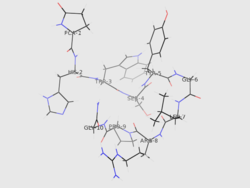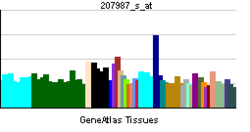- Gonadotropin-releasing hormone
-
Gonadotropin-releasing hormone (GnRH), also known as Luteinizing-hormone-releasing hormone (LHRH) and luliberin, is a tropic peptide hormone responsible for the release of follicle-stimulating hormone (FSH) and luteinizing hormone (LH) from the anterior pituitary. GnRH is synthesized and released from neurons within the hypothalamus. The peptide belongs to gonadotropin-releasing hormone family.
Contents
Production
The gene, GNRH1, for the GnRH precursor is located on chromosome 8. In mammals, the linear decapeptide end-product is synthesized from a 92-amino acid preprohormone in the preoptic anterior hypothalamus.
Structure
The identity of GnRH was clarified by the 1977 Nobel Laureates Roger Guillemin and Andrew V. Schally:
pyroGlu-His-Trp-Ser-Tyr-Gly-Leu-Arg-Pro-Gly-NH2
GnRH as a neurohormone
GnRH is considered a neurohormone, a hormone produced in a specific neural cell and released at its neural terminal. A key area for production of GNRH is the preoptic area of the hypothalamus, which contains most of the GnRH-secreting neurons. GnRH neurons originate in the nose and migrate into the brain, where they are scattered throughout the medial septum and hypothalamus and connected by very long >1-millimeter-long dendrites. These bundle together so they receive shared synaptic input, a process that allows them to synchronize their GnRH release.[1]
GnRH is secreted in the hypophysial portal bloodstream at the median eminence. The portal blood carries the GnRH to the pituitary gland, which contains the gonadotrope cells, where GnRH activates its own receptor, gonadotropin-releasing hormone receptor (GnRHR), a seven-transmembrane G-protein-coupled receptor that stimulates the beta isoform of Phosphoinositide phospholipase C, which goes on to mobilize calcium and protein kinase C. This results in the activation of proteins involved in the synthesis and secretion of the gonadotropins LH and FSH. GnRH is degraded by proteolysis within a few minutes.
Control of FSH and LH
At the pituitary, GnRH stimulates the synthesis and secretion of the gonadotropins, follicle-stimulating hormone (FSH), and luteinizing hormone (LH). These processes are controlled by the size and frequency of GnRH pulses, as well as by feedback from androgens and estrogens. Low-frequency GnRH pulses lead to FSH release, whereas high-frequency GnRH pulses stimulate LH release.
There are differences in GnRH secretion between females and males. In males, GnRH is secreted in pulses at a constant frequency, but, in females, the frequency of the pulses varies during the menstrual cycle, and there is a large surge of GnRH just before ovulation.
GnRH secretion is pulsatile in all vertebrates, and is necessary for correct reproductive function. Thus, a single hormone, GnRH1, controls a complex process of follicular growth, ovulation, and corpus luteum maintenance in the female, and spermatogenesis in the male.
Activity
GnRH activity is very low during childhood, and is activated at puberty. During the reproductive years, pulse activity is critical for successful reproductive function as controlled by feedback loops. However, once a pregnancy is established, GnRH activity is not required. Pulsatile activity can be disrupted by hypothalamic-pituitary disease, either dysfunction (i.e., hypothalamic suppression) or organic lesions (trauma, tumor). Elevated prolactin levels decrease GnRH activity. In contrast, hyperinsulinemia increases pulse activity leading to disorderly LH and FSH activity, as seen in polycystic ovary syndrome (PCOS). GnRH formation is congenitally absent in Kallmann syndrome.
The GnRH neurons are regulated by many different afferent neurons, using several different transmitters (including norepinephrine, GABA, glutamate). For instance, dopamine appears to stimulate LH release (through GnRH) in estrogen-progesterone-primed females; dopamine may inhibit LH release in ovariectomized females.[2] Kisspeptin appears to be an important regulator of GnRH release.[3] GnRH release can also be regulated by estrogen. It has been reported that there are kisspeptin-producing neurons that also express estrogen receptor alpha.[4]
GnRH in other organs
GnRH is found in organs outside of the hypothalamus and pituitary, and its role in other life processes is poorly understood. For instance, there is likely to be a role for GnRH1 in the placenta and in the gonads. GnRH and GnRH receptors are also found in cancers of the breast, ovary, prostate, and endometrium.[5]
Medication
GnRH is available as gonadorelin hydrochloride(Factrel®)and gonadorelin diacetate tetrahydrate(Cystorelin®)for injectable use. Studies have described it being used via an infusion pump system to induce ovulation in patients with hypothalamic hypogonadism. It is also used in veterinary medicine as a treatment for cattle with cystic ovarian disease.
Its analogue Leuprolide is used for continuous infusion, to treat Breast carcinoma, endometriosis, prostate carcinoma, and precocious puberty.
Agonists and antagonists
While GnRH has been synthesized and become available, its short half-life requires infusion pumps for its clinical use. Modifications of the decapeptide structure of GnRH have led to GnRH1 analog medications that either stimulate (GnRH1 agonists) or suppress (GnRH antagonists) the gonadotropins. It is important to note that, through downregulation, agonists are also able to exert a prolonged suppression effect.
References
- ^ Campbell RE, Gaidamaka G, Han SK, Herbison AE (June 2009). "Dendro-dendritic bundling and shared synapses between gonadotropin-releasing hormone neurons". Proc. Natl. Acad. Sci. U.S.A. 106 (26): 10835–40. doi:10.1073/pnas.0903463106. PMC 2705602. PMID 19541658. http://www.pubmedcentral.nih.gov/articlerender.fcgi?tool=pmcentrez&artid=2705602.
- ^ Brown RM (1994). An introduction to Neuroendocrinology. Cambridge, UK: Cambridge University Press. ISBN 0-521-42665-0.
- ^ Dungan HM, Clifton DK, Steiner RA (March 2006). "Minireview: kisspeptin neurons as central processors in the regulation of gonadotropin-releasing hormone secretion". Endocrinology 147 (3): 1154–8. doi:10.1210/en.2005-1282. PMID 16373418.
- ^ Franceschini I, Lomet D, Cateau M, Delsol G, Tillet Y, Caraty A (July 2006). "Kisspeptin immunoreactive cells of the ovine preoptic area and arcuate nucleus co-express estrogen receptor alpha". Neurosci. Lett. 401 (3): 225–30. doi:10.1016/j.neulet.2006.03.039. PMID 16621281.
- ^ Schally AV (1999). "Luteinizing hormone-releasing hormone analogs: their impact on the control of tumorigenesis.". Peptides 20 (10): 1247–62. doi:10.1016/S0196-9781(99)00130-8. PMID 10573298.
Further reading
- Flanagan CA, Millar RP, Illing N (1998). "Advances in understanding gonadotrophin-releasing hormone receptor structure and ligand interactions". Rev. Reprod. 2 (2): 113–20. doi:10.1530/ror.0.0020113. PMID 9414473.
- Leung PC, Cheng CK, Zhu XM (2004). "Multi-factorial role of GnRH-I and GnRH-II in the human ovary". Mol. Cell. Endocrinol. 202 (1–2): 145–53. doi:10.1016/S0303-7207(03)00076-5. PMID 12770744.
- Gründker C, Emons G (2004). "Role of gonadotropin-releasing hormone (GnRH) in ovarian cancer". Reprod. Biol. Endocrinol. 1: 65. doi:10.1186/1477-7827-1-65. PMC 239893. PMID 14594454. http://www.pubmedcentral.nih.gov/articlerender.fcgi?tool=pmcentrez&artid=239893.
- Limonta P, Moretti RM, Marelli MM, Motta M (2004). "The biology of gonadotropin hormone-releasing hormone: role in the control of tumor growth and progression in humans". Frontiers in neuroendocrinology 24 (4): 279–95. doi:10.1016/j.yfrne.2003.10.003. PMID 14726258.
- Janáky T, Juhász A, Bajusz S, et al. (1992). "Analogues of luteinizing hormone-releasing hormone containing cytotoxic groups". Proc. Natl. Acad. Sci. U.S.A. 89 (3): 972–6. doi:10.1073/pnas.89.3.972. PMC 48367. PMID 1310542. http://www.pubmedcentral.nih.gov/articlerender.fcgi?tool=pmcentrez&artid=48367.
- Healey SC, Martin NG, Chenevix-Trench G (1991). "NcoI RFLP of the human LHRH gene on chromosome 8p". Nucleic Acids Res. 19 (21): 6059. doi:10.1093/nar/19.21.6059. PMC 329079. PMID 1682898. http://www.pubmedcentral.nih.gov/articlerender.fcgi?tool=pmcentrez&artid=329079.
- Williamson P, Lang J, Boyd Y (1992). "The gonadotropin-releasing hormone (Gnrh) gene maps to mouse chromosome 14 and identifies a homologous region on human chromosome 8". Somat. Cell Mol. Genet. 17 (6): 609–15. doi:10.1007/BF01233626. PMID 1767338.
- Hayflick JS, Adelman JP, Seeburg PH (1989). "The complete nucleotide sequence of the human gonadotropin-releasing hormone gene". Nucleic Acids Res. 17 (15): 6403–4. doi:10.1093/nar/17.15.6403. PMC 318303. PMID 2671939. http://www.pubmedcentral.nih.gov/articlerender.fcgi?tool=pmcentrez&artid=318303.
- Nikolics K, Mason AJ, Szönyi E, et al. (1985). "A prolactin-inhibiting factor within the precursor for human gonadotropin-releasing hormone". Nature 316 (6028): 511–7. doi:10.1038/316511a0. PMID 2863757.
- Adelman JP, Mason AJ, Hayflick JS, Seeburg PH (1986). "Isolation of the gene and hypothalamic cDNA for the common precursor of gonadotropin-releasing hormone and prolactin release-inhibiting factor in human and rat". Proc. Natl. Acad. Sci. U.S.A. 83 (1): 179–83. doi:10.1073/pnas.83.1.179. PMC 322815. PMID 2867548. http://www.pubmedcentral.nih.gov/articlerender.fcgi?tool=pmcentrez&artid=322815.
- Yang-Feng TL, Seeburg PH, Francke U (1986). "Human luteinizing hormone-releasing hormone gene (LHRH) is located on short arm of chromosome 8 (region 8p11.2----p21)". Somat. Cell Mol. Genet. 12 (1): 95–100. doi:10.1007/BF01560732. PMID 3511544.
- Seeburg PH, Adelman JP (1984). "Characterization of cDNA for precursor of human luteinizing hormone releasing hormone". Nature 311 (5987): 666–8. doi:10.1038/311666a0. PMID 6090951.
- Tan L, Rousseau P (1983). "The chemical identity of the immunoreactive LHRH-like peptide biosynthesized in the human placenta". Biochem. Biophys. Res. Commun. 109 (3): 1061–71. doi:10.1016/0006-291X(82)92047-2. PMID 6760865.
- Dong KW, Yu KL, Roberts JL (1994). "Identification of a major up-stream transcription start site for the human progonadotropin-releasing hormone gene used in reproductive tissues and cell lines". Mol. Endocrinol. 7 (12): 1654–66. doi:10.1210/me.7.12.1654. PMID 8145771.
- Kakar SS, Jennes L (1996). "Expression of gonadotropin-releasing hormone and gonadotropin-releasing hormone receptor mRNAs in various non-reproductive human tissues". Cancer Lett. 98 (1): 57–62. doi:10.1016/S0304-3835(06)80010-8. PMID 8529206.
- Nagy A, Schally AV, Armatis P, et al. (1996). "Cytotoxic analogs of luteinizing hormone-releasing hormone containing doxorubicin or 2-pyrrolinodoxorubicin, a derivative 500-1000 times more potent". Proc. Natl. Acad. Sci. U.S.A. 93 (14): 7269–73. doi:10.1073/pnas.93.14.7269. PMC 38972. PMID 8692981. http://www.pubmedcentral.nih.gov/articlerender.fcgi?tool=pmcentrez&artid=38972.
- Chegini N, Rong H, Dou Q, et al. (1996). "Gonadotropin-releasing hormone (GnRH) and GnRH receptor gene expression in human myometrium and leiomyomata and the direct action of GnRH analogs on myometrial smooth muscle cells and interaction with ovarian steroids in vitro". J. Clin. Endocrinol. Metab. 81 (9): 3215–21. doi:10.1210/jc.81.9.3215. PMID 8784072.
- Bonaldo MF, Lennon G, Soares MB (1997). "Normalization and subtraction: two approaches to facilitate gene discovery". Genome Res. 6 (9): 791–806. doi:10.1101/gr.6.9.791. PMID 8889548.
- Dong KW, Yu KL, Chen ZG, et al. (1997). "Characterization of multiple promoters directing tissue-specific expression of the human gonadotropin-releasing hormone gene". Endocrinology 138 (7): 2754–62. doi:10.1210/en.138.7.2754. PMID 9202214.
- Twan WH, Hwang JS, Lee YH, Jeng SR, Yueh WS, Tung YH, Wu HF, Dufour S, Chang CF (January 2006). "The presence and ancestral role of gonadotropin-releasing hormone in the reproduction of scleractinian coral, Euphyllia ancora". Endocrinology 147 (1): 397–406. doi:10.1210/en.2005-0584. PMID 16195400.
Endocrine system: hormones (Peptide hormones · Steroid hormones) Endocrine
glandsTestis: testosterone · AMH · inhibin
Ovary: estradiol · progesterone · activin and inhibin · relaxin (pregnancy)
Placenta: hCG · HPL · estrogen · progesteroneIslet-Acinar
AxisNon-end.
glandsThymus: Thymosin (Thymosin α1, Thymosin beta) · Thymopoietin · Thymulin
Digestive system: Stomach: gastrin · ghrelin · Duodenum: CCK · GIP · secretin · motilin · VIP · Ileum: enteroglucagon · peptide YY · Liver/other: Insulin-like growth factor (IGF-1, IGF-2)
Adipose tissue: leptin · adiponectin · resistin
Kidney: JGA (renin) · peritubular cells (EPO) · calcitriol · prostaglandin
Heart: Natriuretic peptide (ANP, BNP)Peptides: neuropeptides Hormones see hormonesOpioid peptides OthersOther neuropeptides NeuromedinsOtherAngiotensin · Bombesin · Calcitonin gene-related peptide · Carnosine · Cocaine and amphetamine regulated transcript · Delta sleep-inducing peptide · FMRFamide · Galanin · Galanin-like peptide · Gastrin releasing peptide · Neuropeptide S · Neuropeptide Y · Neurophysins · Neurotensin · Pancreatic polypeptide · Pituitary adenylate cyclase activating peptide · RVD-Hpα · VGFNeurotransmitters Amino acids Alanine · Aspartate · Cycloserine · DMG · GABA · Glutamate · Glycine · Hypotaurine · Kynurenic acid (Transtorine) · NAAG (Spaglumic acid) · NMG (Sarcosine) · Serine · Taurine · TMG (Betaine)
Endocannabinoids 2-AG · 2-AGE (Noladin ether) · AEA (Anandamide) · NADA · OAE (Virodhamine) · Oleamide · PEA (Palmitoylethanolamide) · RVD-Hpα · Hp (Hemopressin)
Gasotransmitters Monoamines Purines Trace amines 3-ITA · 5-MeO-DMT · Bufotenin · DMT · NMT · Octopamine · Phenethylamine · Synephrine · Thyronamine · Tryptamine · Tyramine
Others 1,4-BD · Acetylcholine · GBL · GHB · Histamine
Categories:- Human proteins
Wikimedia Foundation. 2010.


